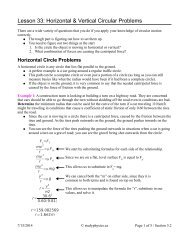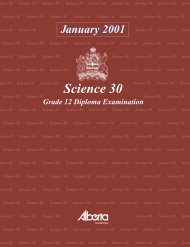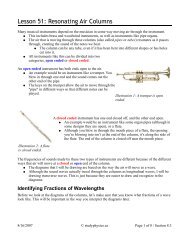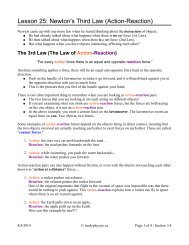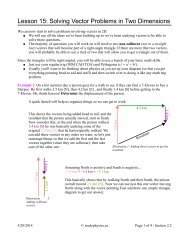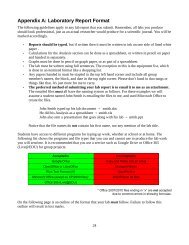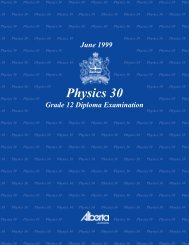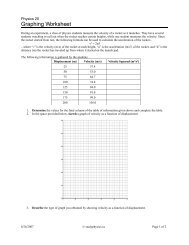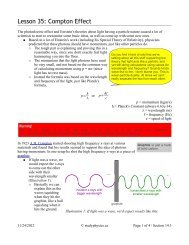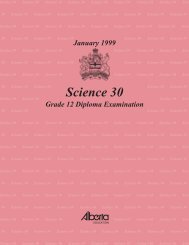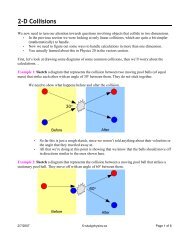Lesson 33: Photoelectric Effect
Lesson 33: Photoelectric Effect
Lesson 33: Photoelectric Effect
You also want an ePaper? Increase the reach of your titles
YUMPU automatically turns print PDFs into web optimized ePapers that Google loves.
<strong>Lesson</strong> <strong>33</strong>: <strong>Photoelectric</strong> <strong>Effect</strong>Hertz ExperimentHeinrich Hertz was doing experiments in 1887 to test some of Maxwell's theories of EMR.● One of the experiments involved using a coil of wire as a receiver to detect EMR produced by aseparate device.○ This was very much like Maxwell's own experiments with low frequency AC radiation.● Hertz was having problems seeing the spark that was made by the coil, so he placed the wholething inside a dark box and looked through a glass window.○ Funny thing was, the sparks seemed shorter now. He could see them in the dark, but theyjust weren't as big anymore.●●●Hertz noticed that when he changed the glass window to one made out of quartz, the sparks gotbigger.○ The big difference is that the glass blocks UV, but the quartz does not.In the end, Hertz concluded that if random UV radiation in the room was able to go into the box(it could only do that if glass did not block it) it would hit the coil and help electrons pop offmaking bigger sparks.Hertz did not try to figure out why this was happening.Einstein's ExplanationThreshold FrequencyEinstein figured out that it was the frequency of the light hitting the metal that was important.● When the UV light hit the metal of the coil, it had enough energy to knock off electrons.○ This was happening because the individual photons of UV had enough energy according tothe formula E = hf.● If the metal is exposed to radiation with a frequency less than UV, nothing happened.○ Since the frequency of the light is so low, each photon does not have enough energy toknock off the electrons.● This critical minimum frequency that is needed to start knocking off the electrons was namedthe threshold frequency.○ The special symbol used for it in formulas is f o .Work FunctionEinstein believed that to give a single electron the energy to move, the metal was hit by a single photon(destroying itself), and transferred its energy to the one electron.● Since the electron is originally attached to the metal, some minimum amount of energy must beneeded just to snap it off. Otherwise, electrons would just be dropping off of atoms all the time.● Einstein called this the work function of the metal, since you needed to do work on the electronto break it off.○ Every metal has its own work function, since different metals hold on to their electrons withdifferent strengths.● Popping the electrons off starts to happen at a minimum threshold frequency, so that mustcorrespond to the work function.○ The formula for this is a modification of Planck's formula.11/24/2012 © studyphysics.ca Page 1 of 5 / Section 14.2
E=hfW =h f oW = work function (J)h = Planck's Constantf o = threshold frequency (Hz)Warning!Ok, sure, this formula is almost exactly the same as Planck's. The difference here is what we're talking about. Planck's formula isabout any photon of EMR. The formula for work function is all about minimum energy needed to knock electrons off a metal. You mustuse the work function formula when calculating things concerning electrons being knocked off to show that you understand we are notjust talking about the photons themselves.●●Just like Planck's formula, you can use the value for Planck's constant in electron volts and getyour final answer in electron volts.○ In fact, it is very common to give the value for the work function in electron volts.You could also use a maximum threshold wavelength instead of the minimum thresholdfrequency.Example 1: Determine the threshold frequency of a material with a work function of 10eV.Since the value for the work function is given in electron volts, we might as well use the valuefor Planck’s constant that is in eV·s.W =hf of o= W hf o= 104.14e-15f o=2.41546e15=2.4e15 HzExample 2: Determine the work function of a metal in Joules if the maximum threshold wavelength is1.10e-7 m.W =hf oW = hcλ oW = 6.63e-34(3.00e8)1.10e-7W=1.80818e-18=1.81e-18JRemember that c = f λ so we can changethe formula just like we did for Planck'sformula.11/24/2012 © studyphysics.ca Page 2 of 5 / Section 14.2
Millikan's Measurements of the <strong>Photoelectric</strong> <strong>Effect</strong>Robert Millikan set up an experiment using the following apparatus.A UV light source was aimed at a piece of zinc inside avacuum tube.● With the UV source turned on a current wasshown on the ammeter.○ How could a current flow when there is ahuge gap between the wires in the tube?○○○It was reasoned that when the UV light hitthe zinc plate, the photons of UV knockedelectrons off the zinc. These electrons flyacross the tube and hit the metal plate.The result is a negative charge on the metalplate (it's gaining electrons) and a positivecharge on the zinc plate (it lost theelectrons).Current flows in the wire, as the electrons move from the metal plate back to the zincplate.Stopping VoltageTo further test these ideas we can turn on the variable voltage source.● Notice that the variable voltage source is set up so that the metal plate will be negative and thezinc plate becomes positive.●●●Illustration 1: <strong>Photoelectric</strong> <strong>Effect</strong> apparatusThis voltage should work against the electrons getting all the way from the zinc plate to themetal plate. Only electrons with enough kinetic energy (going fast enough) will be able to get tothe metal plate.○ Any electrons that have too little energy will just get pushed back by the negatively chargedmetal plate and stick back onto the zinc plate.The voltage was slowly increased from zero, and for a while nothing appeared to be changing.But, there came a point when the voltage became too great for even the fastest moving electronsto get across the gap. At this point (and for any higher voltages) the ammeter gives a reading ofzero.○ This is the stopping voltage, the voltage that is enough to get rid of all the kinetic energy theelectrons had trying to get across the tube.We can come up with a formula for this by relating it to the ideas we have from <strong>Lesson</strong> 13 onvoltage.V = Eq E=qVE k max =qV stopE k max = the kinetic energy of thefastest moving electrons (J)q = charge of an electron (C)V stop = the voltage needed tostop the electrons (V)11/24/2012 © studyphysics.ca Page 3 of 5 / Section 14.2
Example 3: Determine the maximum kinetic energy of electrons emitted from a zinc surface if theyare stopped by a 16 N/C uniform electric field over a distance of 3.0cm.First calculate the voltage.∣E∣= V d V =∣E∣ d V =160.030 V =0.48VThen figure out the maximum kinetic energy of the fastest moving electrons.E k max=qV stopE k max=1.60e-19(0.48)E k max=7.68e-20=7.7e-20 J<strong>Photoelectric</strong> <strong>Effect</strong> Formula (the Biggy!)If the frequency of the incoming light is great enough, there should be enough energy to break off theelectron and have some left over to give it some kinetic energy. So…hf =E k maxWInput EnergyThis is the energyof the incomingphoton.Maximum KineticEnergyThis is the part ofthe energy thatallows the electronto move.This is really a formula that shows conservation of energy.● The original input energy is from the incomingphoton.● Some of this energy is used to just snap off theelectron from the metal. This is the work function.● Any left over energy becomes kinetic energy used bythe electron to go zipping across the tube.Work FunctionThis is the energythat is needed tosnap off theelectron.Note, some electrons will need more thanthe bare minimum W to be released (theymight be attracted more strongly), so theirE kis not as great as the maximum. That’sok, though, since we’ll only worry aboutthe electrons that came off the easiestand have the maximum kinetic energy.This formula is built from separate formulas on your data sheet.● From the way that we've seen that each of those individual parts can be changed around, we canadjust this basic formula to fit a particular problem as necessary.11/24/2012 © studyphysics.ca Page 4 of 5 / Section 14.2
Example 4: The threshold frequency of silver is 1.14e15 Hz. EMR with a wavelength of 2.50e-7 mstrikes a piece of pure silver. Determine the speed of the electrons that are emitted.First we'll figure out how much kinetic energy the electrons are getting. We will have tosubstitute formulas into the one we've built so far.hf =E k max+Whcλ =E +hf k max oE k max= hcλ −hf oE k max= 6.63e-34(3.00e8) −6.63e-34(1.14e15)2.50e-7E k max =3.978e-20=3.98e-20JNow figure out the velocity of the electron.E k max= 1 2 mv2v=√ 2 E k maxmv=√ 2(3.98e-20)9.11e-31v=295521=2.96e5m/sHomeworkp716 #1-3p718 #1-2p719 #1-3p720 #2, 6, 711/24/2012 © studyphysics.ca Page 5 of 5 / Section 14.2



